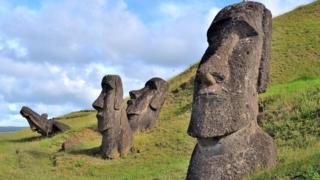Home » Latin America »
Truck crashes into Easter Island sacred statue
The mayor of Easter Island has called for motor restrictions to be put in place in the area after a truck collided with a sacred stone statue.
Pedro Edmunds Paoa told local media that the incident had caused “incalculable” damage.
A Chilean man who lives on the island was arrested on Sunday and charged with damaging a national monument, local media report.
The platform on which the statue was mounted was also destroyed.
Stone statues were carved by the indigenous Rapa Nui people to embody the spirit of a prominent ancestor.
About 1,000 of the figures – known as moai – exist on the island, which hosts about 12,000 tourists a month.
“Everyone decided against establishing traffic rules when it came to vehicles on sacred sites – but we, as a council, were talking about the dangers and knew very well what the rise in tourist and resident numbers could mean”, Mr Edmunds Poa told the El Mercurio newspaper.
“They didn’t listen to us and this is the result,” he said.
In a Facebook post, the Ma’u Henu indigenous community said it was of vital importance to “protect culture heritage”.
“They are not just archaeological remains, they are sacred elements of a living culture and fundamental to our Rapa Nui world vision.”
What do we know about the moai?
Nearly 1,000 giant stone statues and carvings – the largest of which weigh 74 tonnes and stand 10m tall – remain on the island.
The figures were carved by the indigenous Rapa Nui people sometime between the years of 1400 and 1650 and positioned to form a ring around the island, facing inland.
Best known for their deep-set eyes and long ears, they also sport impressive multi-tonne hats.
For the Rapa Nui, they were figures of spiritual devotion, embodying the spirit of a prominent ancestor. Each one was considered to be the person’s living incarnation.
One of the statues – known as the Hoa Hakananai’a – is housed in the British Museum, gifted by a British naval captain to Queen Victoria in the 1860s.
The Chilean government and the island’s authorities requested it be returned in 2018.
But the island’s mayor suggested he would prefer a financial commitment from the museum to ensure the upkeep of the remaining moai on the island.
Source: Read Full Article



